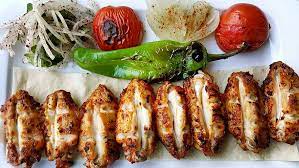Turkish cuisine stands as a testament to the country's rich history, diverse cultural influences, and an unwavering passion for flavor. Situated at the crossroads of Europe and Asia, Turkey has absorbed culinary influences from various civilizations that have left their mark on its food. From savory kebabs to delicate pastries, Turkish food offers a tantalizing journey through flavors, aromas, and traditions.
Historical Influences: A Culinary Melting Pot
Turkish cuisine is a tapestry woven with the threads of various historical influences, each contributing to the rich and diverse flavors that define it today. The culinary heritage of Turkey has been shaped by the interplay of Byzantine, Ottoman, Persian, Arab, Central Asian, and Mediterranean cultures, resulting in a unique amalgamation of ingredients, techniques, and dishes.
The Byzantine Empire's influence introduced a penchant for using vegetables, olive oil, and honey in cooking, laying the foundation for the prominence of these elements in modern Turkish cuisine. The Ottomans, who ruled over vast territories, incorporated flavors from their expansive realm, infusing the cuisine with spices, fruits, and sweets from the Arab world and the Mediterranean.
The Central Asian nomadic tribes brought their mastery of meat preparation, which is evident in the art of grilling and roasting, as seen in kebabs and other meat-centric dishes. Meanwhile, Persian culinary traditions contributed intricate rice pilafs, aromatic herbs, and the concept of combining sweet and savory flavors.
The Silk Road, a network of trade routes connecting the East and West, played a pivotal role in shaping Turkish cuisine by facilitating the exchange of ingredients like spices, nuts, and dried fruits from distant lands. These ingredients were skillfully woven into the culinary fabric of Turkey, adding depth and complexity to its flavors.
The coastal regions of Turkey, bordered by the Aegean, Mediterranean, and Black Seas, have been influenced by maritime cultures, resulting in a heavy emphasis on seafood in their culinary repertoire.
In summary, the historical influences on Turkish cuisine have created a harmonious blend of flavors, techniques, and ingredients that reflect the cultural diversity and richness of the region. The journey through Turkish cuisine is not just a gastronomic experience but also a captivating exploration of history and heritage.
Signature Dishes: A Gastronomic Adventure
Kebabs: A cornerstone of Turkish cuisine, kebabs come in various forms, such as shish kebab (marinated meat skewers) and döner kebab (rotating, thinly sliced meat). These succulent delights are typically accompanied by rice, vegetables, and tangy sauces.
The Döner or Döner kebab, a beloved Turkish street food, is a mouthwatering delight composed of succulent slices of seasoned meat, often lamb or chicken, rotating on a vertical rotisserie. Served in a variety of ways, from a warm pita bread wrap to a hearty plate with accompaniments, the döner kebab is a culinary icon that embodies the fusion of flavors and cultures in Turkish cuisine.
Meze: A culinary tradition that encourages communal dining, meze are a variety of small, flavorful dishes. Ranging from creamy hummus and smoky eggplant dips to stuffed grape leaves and spicy sausages, meze showcase the diverse flavors of Turkey.
Pide: Often referred to as Turkish pizza, pide is a boat-shaped flatbread topped with an array of ingredients like cheese, minced meat, vegetables, and herbs. The dough is skillfully folded over the filling, resulting in a delightful mix of textures and flavors.
Baklava: A sweet treat that has gained worldwide fame, baklava consists of layers of thin pastry dough, nuts (typically pistachios or walnuts), and sweet syrup. Its delicate layers and rich taste make it a cherished dessert.
Turkish Delight: Known as "lokum," Turkish delight is a chewy, sugar-dusted confection made from starch, sugar, flavorings, and often nuts or dried fruits. Its unique texture and wide range of flavors have made it a beloved treat for centuries.
Turkish Tea and Coffee: The ritual of tea and coffee drinking is deeply ingrained in Turkish culture. Turkish tea, typically served in small, tulip-shaped glasses, is a symbol of hospitality. Meanwhile, Turkish coffee is prepared using finely ground beans and is known for its rich, strong taste.
Regional Flavors: A Voyage Across Turkey
Turkish cuisine is as diverse as its landscape, with each region contributing unique flavors and specialties. For instance:
Anatolia: Home to iconic dishes like kebabs and baklava, Anatolia boasts a rich culinary history influenced by the Ottomans.
Istanbul: As a bridge between East and West, Istanbul offers a fusion of flavors. Try the iconic fish sandwich from the bustling Eminönü district or indulge in a historical Ottoman feast.
Cappadocia: This region is known for its pottery kebabs, which are slow-cooked in clay pots, allowing the flavors to meld beautifully.
Aegean and Mediterranean Coasts: Seafood takes center stage here, with dishes like "midye dolma" (stuffed mussels) and grilled octopus being highlights.
Southeastern Anatolia: The cuisine here features bold spices, lamb-based dishes, and savory pastries like "lahmacun" (Turkish pizza).
A Culinary Legacy
Turkish cuisine is more than just a collection of dishes; it reflects the cultural, historical, and geographical diversity of the nation. It's a testament to the way food brings people together, forging connections across generations and backgrounds. Whether you're savoring the smoky aroma of a kebab, sharing stories over a cup of tea, or indulging in the delicate layers of baklava, Turkish cuisine invites you to partake in a gastronomic journey that's as vibrant as the country itself.


No comments yet